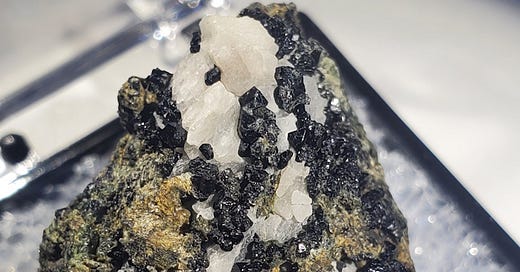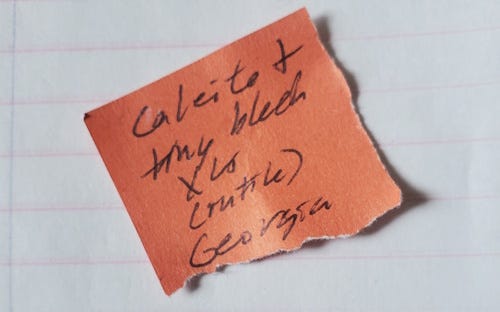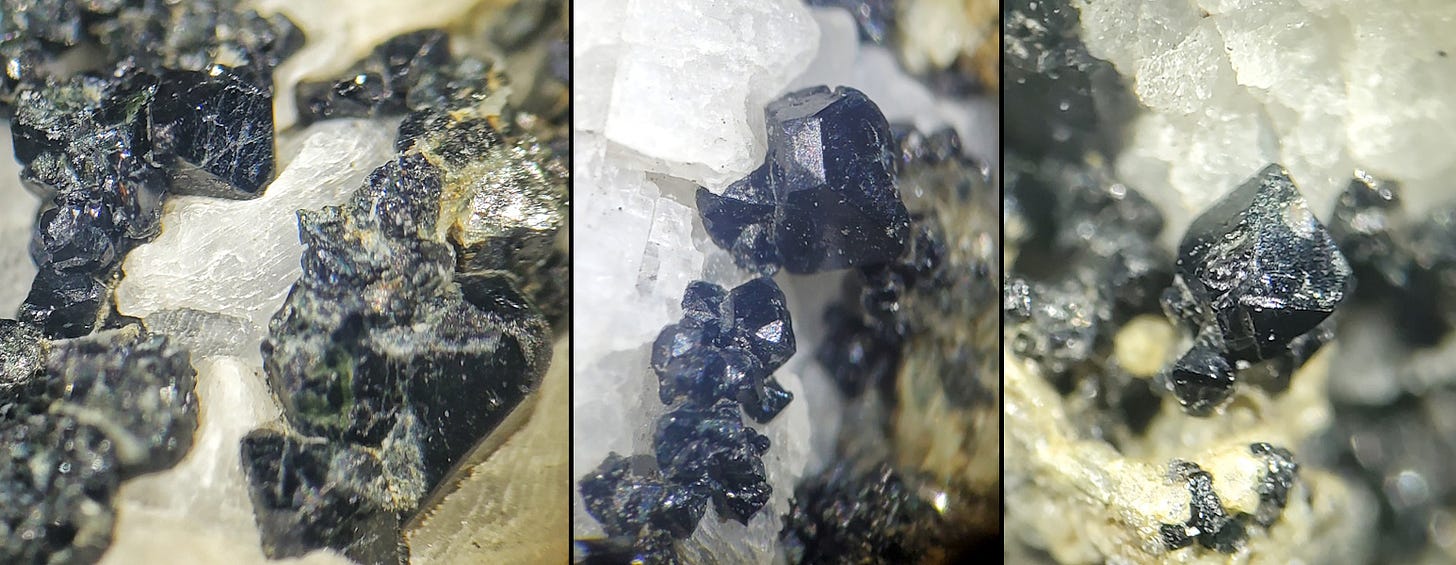Life in the USA is not normal. It feels pointless and trivial to be talking about small looks at the fascinating natural world when the country is being dismantled. But these posts will continue, as a statement of resistance. I hope you continue to enjoy and learn from them. Stand Up For Science!
I’ve posted previously about my habit of sometimes acquiring a specimen without a label, for the pleasure of trying to figure out what it is, where it is from, or both.
Sometimes I’ll pick up something where I’m pretty sure the label is wrong, with the same pursuit in mind. This time it was the 3-cm item in the top photo, which cost $2.00. The label, scribbled on a torn scrap of paper, said "calcite & tiny black xls (rutile) – Georgia." The crystals are indeed tiny, no more than a millimeter or so, but even to the naked eye I thought it wasn’t rutile, titanium dioxide, TiO2.
Under the microscope, the black crystals are to my eye clearly octahedrons, a few with small cube or second-order octahedrons or some other form on the terminations. Rutile is tetragonal, so tetragonal pyramids on short prisms might have an octahedral look, but it would be quite unusual; rutile is typically elongate prismatic, and even if it were a twin, or a pseudomorph after brookite, an octahedral form would be unexpected but not impossible. Rutile could be black, but the slightly greenish-black color of my specimen would be unusual too. The specimen scratches glass easily, but so would rutile, albeit perhaps not quite so easily.
The edges of my crystals are not sharp; many have a gently rounded look sometimes called “melted,” and that’s a typical appearance for spinel, MgAl2O4, which displays many colors, but is often black and it is typically, almost diagnostically, octahedral in form. That was my instant impression on first looking at the specimen under the microscope, and now I’m confident that these little octahedrons are spinel. The associated calcite has clearly been dissolved to reveal them, and there is also some brighter green granular material that I’m sure is diopside, CaMgSi2O6.
Spinel + calcite + diopside is a moderately common association worldwide, often found in skarns. But there is not one photo of spinel from Georgia on MinDat, the online database. That’s not proof there is none, but it suggests spinel is not common in Georgia.
If the black mineral is spinel and not rutile, it begins to argue that the locality, “Georgia,” is also wrong. I suspect that once the idea came that it was rutile, Georgia was added as the locality simply because it’s a well-known US location for rutile.
So now, we consider the backstory of the specimen. I purchased it from the daughter of Chuck Borland, a prominent collector/dealer from Bozeman, Montana, noted for an extensive international inventory but also active in collecting in the Boulder Batholith. He died in 2013.
Apart from the famous blue spinel from the Crazy Sphinx Mine near Helena, there’s exactly one photo of spinel from Montana on MinDat. It was collected in the skarn at Toll Mountain in the Boulder Batholith by prominent Butte collector Chris van Laer, who died in 2016. It is pretty much inconceivable that Borland and van Laer didn’t know each other, and probably swapped specimens even if they never collected together. Van Laer’s specimen on MinDat is spinel, calcite, and diopside, very similar to mine.
So, I conclude confidently that this specimen is spinel, probably from the Toll Mountain Occurrence in the Boulder Batholith of Montana, and was probably collected by either Chuck Borland or Chris van Laer. I can never know this provenance for certain since both collectors have passed on, but I really am confident of the locality now, although it remains an attribution, not a certainty. But just to complicate things, as I mentioned a couple weeks ago, black spinel is also reported by Pete Knudsen from the nearby (and similar) Bald Mountain skarn, although there are no photos on MinDat.
Toll Mountain is part of the “screen,” a zone of skarns between the Butte and Rader Creek Plutons of the Boulder Batholith, about which I have posted previously.
I count this pursuit as a “win,” and even if I’m wrong, the pursuit was well worth the $2.00, and it’s a pleasure also to recall and honor Chuck Borland and Chris van Laer.








Nice sleuthing.
I try to narrow IDs down here, but with white or clear xls I end up with 2 or 3 possibilities I'm unsure of. Micros I mean. Testing is limited.
At least I can be a lumper, not a splitter.